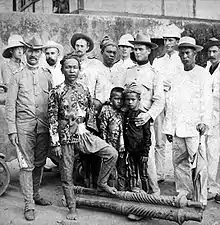Datu Piang
Piang Tan (1846–1933) a Chinese Maguindanaon ruler, popularly known as Datu Piang, is the founder of the royal House of Piang and often referred to as the Grand Old Man of Cotabato.[1]

.jpg.webp)
Born of a Chinese merchant named Tuya Tan (陳名頓) from Amoy, China and a Maguindanaon woman named Tiko, he was Datu Utto's Minister of Lands and became the wealthiest and the most prominent datu during the American era.[2][3][4][5] He was a Chinese mestizo[6] due to his Maguindanao and Chinese mixture.[7][8] Datu Piang (sometimes referred to as Amai Mingka) was recognised as the undisputed Moro leader in Central Mindanao when the United States Army occupied and administered what was then referred to as "Moroland".
Datu Piang's son by his sixth wife, Polindao, was Datu Gumbay Piang, who led the Moro-Bolo Battalion to fight against the Japanese during their occupation of Mindanao in World War II.
See also
- American Occupation of the Philippines
- Insular Government
- United States military government of the Philippine Islands
References
- University of California Press. "Muslim Rulers and Rebels," (Accessed on February 25, 2010).
- "Datu Piang Book Reference," (Accessed on February 25, 2010).
- The Century. Century Company. 1911. pp. 682–.Josiah Gilbert Holland; Richard Watson Gilder (1911). The Century Illustrated Monthly Magazine. Scribner & Company; The Century Company. pp. 682–. Richard Watson Gilder (1911). The Century. Scribner & Company. pp. 682–. Richard Watson Gilder (1911). The Century Illustrated Monthly Magazine. Century Company. pp. 682–. Century Illustrated Monthly Magazine ... Scribner & Company. 1911. pp. 682–. The Century Illustrated Monthly Magazine. The Century Co. 1911. pp. 682–.
- O. W. Wolters (January 1999). History, Culture, and Region in Southeast Asian Perspectives. SEAP Publications. pp. 134–. ISBN 978-0-87727-725-5.
- Leo Suryadinata (2011). Migration, Indigenization and Interaction: Chinese Overseas and Globalization. World Scientific. pp. 237–. ISBN 978-981-4365-91-8.
- Thomas M. McKenna (10 August 1998). Muslim Rulers and Rebels: Everyday Politics and Armed Separatism in the Southern Philippines. University of California Press. pp. 91–. ISBN 978-0-520-91964-8.
- James R. Arnold (26 July 2011). The Moro War: How America Battled a Muslim Insurgency in the Philippine Jungle, 1902-1913. Bloomsbury USA. pp. 132–. ISBN 978-1-60819-024-9.
- Michael Salman (2001). The Embarrassment of Slavery: Controversies Over Bondage and Nationalism in the American Colonial Philippines. University of California Press. pp. 67–. ISBN 978-0-520-22077-5.
- Robert A. Fulton (2007). Moroland, 1899-1906: America's First Attempt to Transform an Islamic Society. Robert Fulton. pp. 61–. ISBN 978-0-9795173-0-3.
- Mark S. Williams (20 June 2011). Business and Peace: The Case of La Frutera Plantation in Datu Paglas, Maguindanao, Philippines. Universal-Publishers. pp. 42–. ISBN 978-1-61233-758-6.